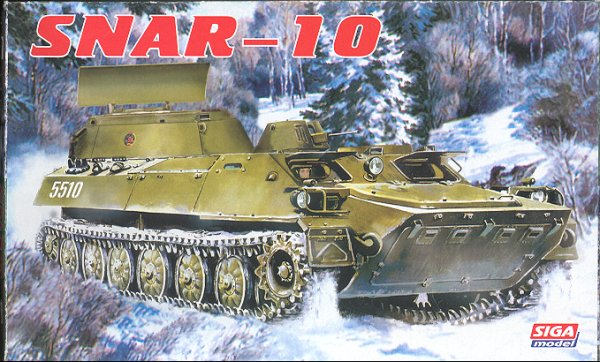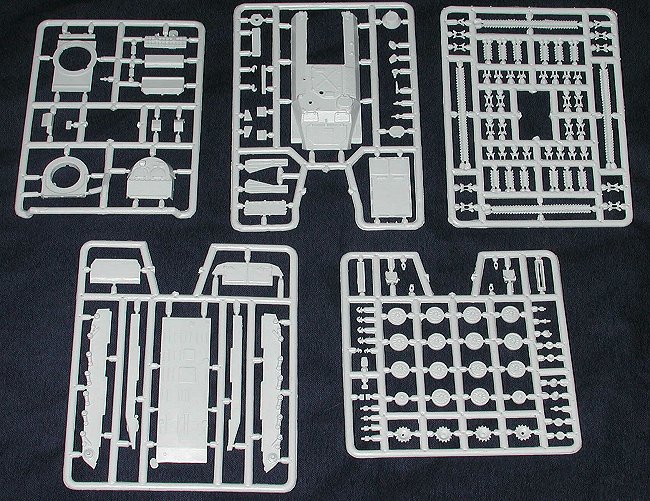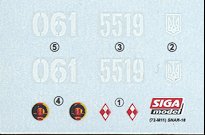
|
KIT: |
SIGA Models 1/72 SNAR-10 |
|
KIT # |
72-M11 |
|
PRICE: |
$ |
|
DECALS: |
See review |
|
REVIEWER: |
|
|
NOTES: |

|
HISTORY |
I'll have to rely on internet sources for the background on this vehicle as I know next to nothing about the subject.
"One of the most widely deployed battlefield surveillance radars of the former Soviet Union was the self-propelled SNAR-10 (Stantsyiya Nazemnoy Artilleriyskoy Razvedki) or"Big Fred" by NATO. The system is a battlefield surveillance radar with a limited artillery locating function. The SNAR-10 is unable to calculate the trajectories of projectiles or locate enemy artillery firing positions from their impact areas. However, the SNAR-10, can provide location data on stationary and moving battlefield targets. It is normally deployed close to infantry or artillery observation posts. The SNAR-10 can provide data on friendly artillery mission impact patterns and can record and registration fire. The SNAR-10 can also detect targets at sea as well as slow, low-flying helicopters and remotely piloted vehicles (RPVs).
The SNAR-10 was introduced into service by the former Soviet Army in 1975. By the early 1980s, the SNAR-10 entered service with several members of the former Warsaw Pact as well as the former Yugoslavian Army. The SNAR-10 has a four-man crew. The SNAR-10 is based on the amphibious MT-LB tracked vehicle with cruising range is up to 475 kilo-meters with 475 liters of diesel fuel stowed in two tanks along each side-wall in the hull. The SNAR-10's communication equipment consists of two HFA/HF R-123M radios (20 to 51.5 MHz), two field telephones and the R-124 internal radio.
To pinpoint position and direction, the SNAR-10 has a built-in
navigation system and additional topographic equipment similar to the BRM1/3
surveillance and reconnaissance vehicles. The radar is a two-dimensional pulse
doppler radar (the operator making the selection), with the complete system
placed inside the turret (except for the power supply). In the pulse mode, it is
impossible to distinguish between moving and stationary targets, and it is,
therefore, not ideal for the surveillance of a saturated battlefield. To detect
moving objects, the doppler mode is more suitable. The SNAR-10 was at one time a
very capable system due to several improvements but is not as capable as the new
Russian Zoopark-1 artillery counter-battery system. In 1997 the Strela Research
Institute carried out upgrades of the SNAR-10 (SNAR-1 OM) radar. The primary
objective of the upgrades was to replace the aged radar equipment, that dates to
1971, with a modern radar system featuring high survivability and
maneuverability on the battlefield due to the use of an armored chassis and
hull."
|
THE KIT |

As with the other small scale SIGA armor kits, this one is also by Ace, a partner company from Kiev. The molding is quite similar to the BRDM-1 kit with thick sprues and a number of attachment points. The whitish-grey plastic is well detailed and most of the parts have some mold seam flash on them that will require cleanup prior to use. Also similar to the other armor kits, there are no sink marks on any of the pieces and there are no ejector pin marks.
This kit is very much like others of its genre in that a large number of the pieces are devoted to the wheels and tracks as well as the various hooks and hand holds. The tracks themselves are made of two lengths of straight track and a number of single tracks for those that must wind their way over the for and aft sprockets.
 The instructions are well done
with construction sequence on one side and painting guide/parts layout on the
other. Down the main portion of the instructions are the overall construction of
the kit with subassemblies shown on a panel to the right. As with the other kits
in the series, colors are generic and some of the small parts (mostly hand
holds) will need to be made with wire. The small decal sheet is very well done
and appears to be quite thin. There are markings for four different vehicles.
One each of the East German, Ukranian, Soviet, and Polish armies. Colors are
either a Dark Green or a Khaki Green. There are photographs of the real
equipment on the sides of the box to assist in building and painting the kit, a
very nice touch.
The instructions are well done
with construction sequence on one side and painting guide/parts layout on the
other. Down the main portion of the instructions are the overall construction of
the kit with subassemblies shown on a panel to the right. As with the other kits
in the series, colors are generic and some of the small parts (mostly hand
holds) will need to be made with wire. The small decal sheet is very well done
and appears to be quite thin. There are markings for four different vehicles.
One each of the East German, Ukranian, Soviet, and Polish armies. Colors are
either a Dark Green or a Khaki Green. There are photographs of the real
equipment on the sides of the box to assist in building and painting the kit, a
very nice touch.
|
CONCLUSIONS |
Overall, it is a very nice little kit of a subject that is both interesting and, at least to me, unknown prior to receiving the kit. If your particular area of interest is 1/72 modern military, then this is a kit that you should be seeking.
Review kit courtesy of SIGA Models. Thanks for your support.
If you would like your product reviewed fairly and quickly by a site that has well over 100,000 visitors a month, please contact me or see other details in the Note to Contributors.